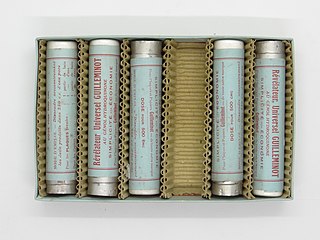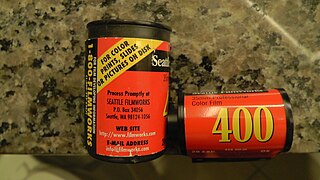External links
- Kodak process E6 Ektachrome (color transparency) processing manual Z-119
- Kodak process E6 Q-LAB processing manual Z-6 (more details than processing manual Z119 above)
- Kodak RA-4 process lab manual Z-130
Replenishment is a component in the processing of photographic film and paper, where fresh chemistry is used to replace exhausted chemistry in a continuous or per-batch fashion. Replenishment rates are calculated by the quantity of film processed in each individual bath; as well as by the amount of film push-processed in the E-6 process; and by film type in the C-41 process.
C-41 color developer exhaustion volumes vary according to the speed and contrast of the films. Please see Table 3-2 in chapter 3 of the Kodak Process C-41 Processing Manual Z-131 (broken link) to see the different color developer exhaustion rates for the various Kodak color negative films.

Kodachrome is the brand name for a color reversal film introduced by Eastman Kodak in 1935. It was one of the first successful color materials and was used for both cinematography and still photography. For many years, Kodachrome was widely used for professional color photography, especially for images intended for publication in print media.
Photographic processing or photographic development is the chemical means by which photographic film or paper is treated after photographic exposure to produce a negative or positive image. Photographic processing transforms the latent image into a visible image, makes this permanent and renders it insensitive to light.

The E-6 process is a chromogenic photographic process for developing Ektachrome, Fujichrome and other color reversal photographic film.

In the processing of photographic films, plates or papers, the photographic developer is one or more chemicals that convert the latent image to a visible image. Developing agents achieve this conversion by reducing the silver halides, which are pale-colored, into silver metal, which is black when in the form of fine particles. The conversion occurs within the gelatine matrix. The special feature of photography is that the developer acts more quickly on those particles of silver halide that have been exposed to light. When left in developer, all the silver halides will eventually be reduced and turn black. Generally, the longer a developer is allowed to work, the darker the image.
C-41 is a chromogenic color print film developing process introduced by Kodak in 1972, superseding the C-22 process. C-41, also known as CN-16 by Fuji, CNK-4 by Konica, and AP-70 by AGFA, is the most popular film process in use, with most, if not all photofinishing labs devoting at least one machine to this development process.

Ektachrome is a brand name owned by Kodak for a range of transparency, still and motion picture films previously available in many formats, including 35 mm and sheet sizes to 11 × 14 inch size. Ektachrome has a distinctive look that became familiar to many readers of National Geographic, which used it extensively for color photographs for decades in settings where Kodachrome was too slow. In terms of reciprocity characteristics, Ektachrome is stable at shutter speeds between ten seconds and 1/10,000 of a second.

Cross processing is the deliberate processing of photographic film in a chemical solution intended for a different type of film. The effect was discovered independently by many different photographers often by mistake in the days of C-22 and E-4. Color cross processed photographs are often characterized by unnatural colors and high contrast. The results of cross processing differ from case to case, as the results are determined by many factors such as the make and type of the film used, the amount of light exposed onto the film and the chemical used to develop the film. Cross processing has been used in a variety of photographic and cinematographic practices, most notably rising in popularity during the 1990s. Similar effects can also be achieved with digital filter effects.

A minilab is a small photographic developing and printing system or machine, as opposed to large centralized photo developing labs. Many retail stores use film or digital minilabs to provide on-site photo finishing services.
The E-4 process is a now outdated process for developing color reversal (transparency) photographic film, which was introduced in 1966.
Eastman Color Negative (ECN) is a photographic processing system created by Kodak in the 1950s for the development of monopack color negative motion picture film stock. It is part of the Eastmancolor family of products sold by Eastman Kodak.
Chromogenic photography is photography that works by a chromogen forming a conventional silver image and then replacing it with a dye image. Most films and papers used for color photography today are chromogenic, using three layers, each providing their own subtractive color. Some chromogenic films provide black-and-white negatives, and are processed in standard color developers. In this case, the dyes are a neutral color.
A chromogenic print, also known as a C-print or C-type print, a silver halide print, or a dye coupler print, is a photographic print made from a color negative, transparency or digital image, and developed using a chromogenic process. They are composed of three layers of gelatin, each containing an emulsion of silver halide, which is used as a light-sensitive material, and a different dye coupler of subtractive color which together, when developed, form a full-color image.

Color motion picture film refers both to unexposed color photographic film in a format suitable for use in a motion picture camera, and to finished motion picture film, ready for use in a projector, which bears images in color.

The E-2 process and E-3 process are outdated processes for developing Ektachrome reversal photographic film. The two processes are very similar, and differ depending on the film. Kodak sold kits that could process either kind of film.

K-14 was the most recent version of the developing process for Kodak's Kodachrome transparency film before its discontinuation. It superseded previous versions of the Kodachrome process used with older films.

Analog photography, also known as film photography, is a term usually applied to photography that uses chemical processes to capture an image, typically on paper, film or a hard plate. These processes were the only methods available to photographers for more than a century prior to the invention of digital photography, which uses electronic sensors to record images to digital media. Analog electronic photography was sometimes used in the late 20th century but soon died out.

In still photography, Kodak's Kodacolor brand has been associated with various color negative films since 1942. Kodak claims that Kodacolor was "the world's first true color negative film". More accurately, it was the first color negative film intended for making paper prints: in 1939, Agfa had introduced a 35 mm Agfacolor negative film for use by the German motion picture industry, in which the negative was used only for making positive projection prints on 35 mm film. There have been several varieties of Kodacolor negative film, including Kodacolor-X, Kodacolor VR and Kodacolor Gold.
RA-4 is Kodak's proprietary name for the chemical process most commonly used to make color photographic prints. It is used for both minilab wet silver halide digital printers of the types most common today in photo labs and drug stores, and for prints made with older-type optical enlargers and manual processing.

Seattle FilmWorks, Inc., was a mail order photographic film processing company that sold re-spooled 35mm motion picture film. It was founded in 1976 as American Passage Marketing by Gilbert Scherer. At its peak in 1997, Seattle FilmWorks employed approximately 800 people and processed about 20 miles of film a day in a 65,000 sq ft lab. In 1978, Seattle FilmWorks started selling motion picture film that is processed using Kodak's ECN-2 process. The film was loaded into 35mm film canisters for still photography use, and the company returned an unexposed roll with each order. In the 1980s, Seattle FilmWorks aggressively marketed its products and services and offered two rolls of Seattle FilmWorks film for US$2.00. It advertised in newspapers, magazines, and package inserts. Seattle FilmWorks was sold and renamed PhotoWorks in 1999. Its marketing practices led to a lawsuit against the company in 2000, which was settled a year later, and the company was later closed.

Cinestill Film is a Los Angeles based company selling photographic film for analog cameras in collaboration with Kodak motion picture cinema film stock. The two brothers who founded the company started as a small business shooting music and wedding photography, hacking cameras and lenses, then moved on to chemically adapting cinema film so it could be processed at photo labs.